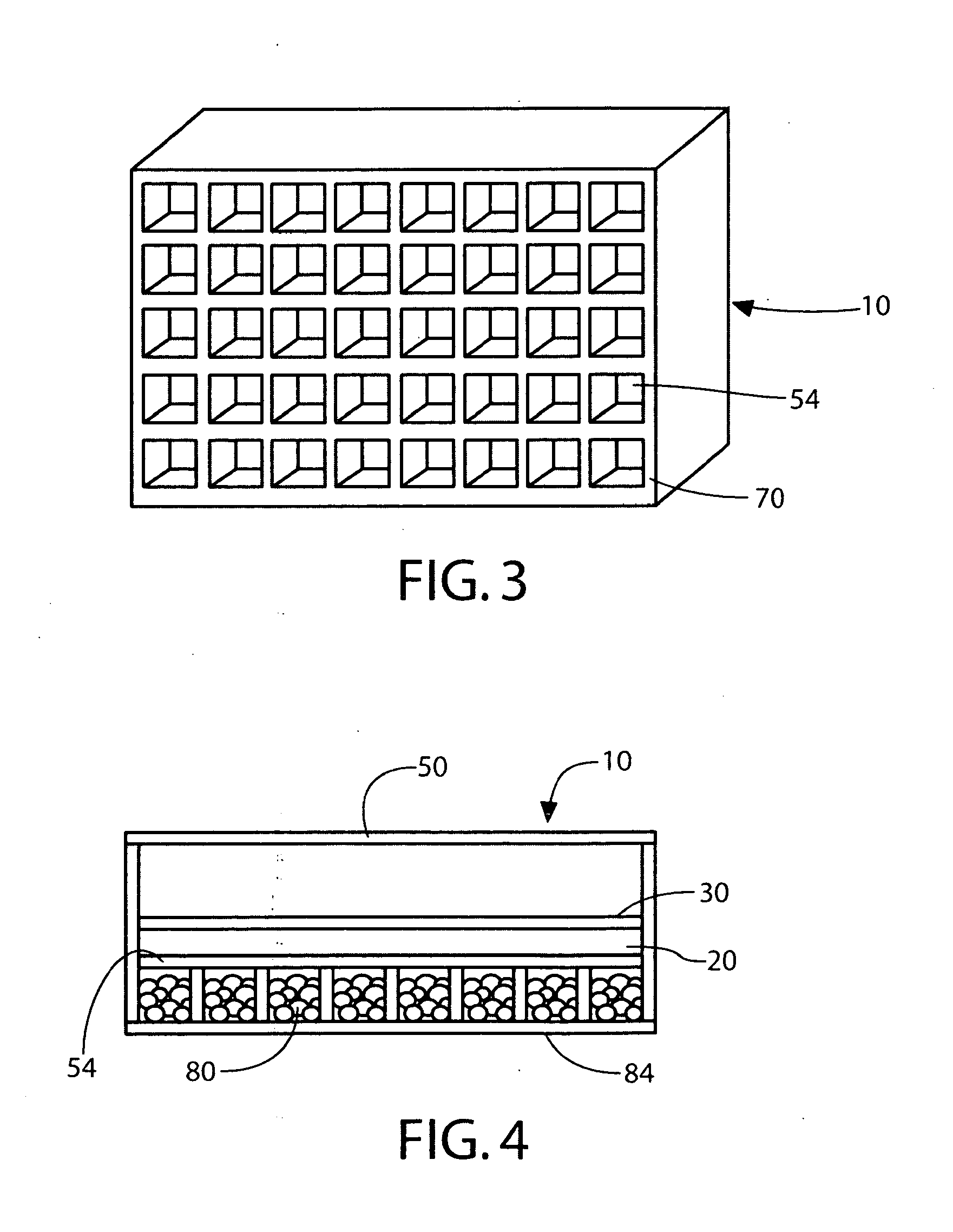Regardless of the cause, explosions arising from rapid
combustion processes generate shock
waves, intense heat, and gas whose pressure significantly exceeds the ambient condition.
This technique does not work for confined environments.
The existing art does not generally provide protection of people for intense blasts in confined environments, with or without venting.
Even when all of the essential considerations are made, weight, space and geometrical constraints often render current technologies inadequate.
Another inadequacy of the present art is inability to defend against a type of munition referred to as a
shaped charge.
Heavy, bulky armor assemblies using the current art are required to prevent penetration of
metal jets produced by
shaped charge devices.
These blast hazards generally inflict serious injury to people in an enclosed space such as a vehicle interior behind the pierced armor, including
traumatic brain injury.
Therefore, values of blast-associated physical parameters are not uniform across the space disturbed by the event.
Thus reflected shocks have faster velocities and generate much more destructive power than the incident
shock wave.
Unlike with
solid explosive materials, scaled distance comparisons of different flammable gases and dusts cannot be made.
Radiation from the
flame front will preheat the unreacted material, which increases its flammability.
The accelerating
flame front will generate turbulence that facilitates
combustion, as will obstacles encountered by the advancing
flame front.
Although an improvement over flat-floored vehicles with respect to reducing QSP, use of such hard material could not reduce reflected blast parameters.
Rigid surfaces generate severe reflected shock in every case.
Thus they fail to substantially dissipate energy through irreversible
aerodynamic drag losses as is possible by using perforated plates or grilles.
They are a solution for moderate and weak blasts, but
mass flow rate in severe blast environments is so great that flow through holes will
choke.
Ground mines typically generate very severe blast conditions.
Perforated deflectors made of conventional materials and with the present art would therefore be ineffective against most anti-armor ground mines.
The greatest challenge to reducing the potential for harm from explosions is determining how to mitigate blast
overpressure and impulse (
momentum transfer).
This is because duration of the
blast load is much more difficult to reduce.
Reducing the time of loading by pressurized gas has heretofore been impossible to achieve when venting of the hot gas is inadequate.
Wall accelerations and acceleration of whole vehicles in these events often inflict severe damage before blast effect dissipates into the surrounding environment.
Second, one must also strive to deflect or divert hot gas around the target.
Fourth, one can create irreversible energy losses through aerodynamic, viscous, and frictional losses.
Partially- and fully-confined explosions within containment substantially lined with two-phase blast-mitigating media have proven even more destructive except for charges smaller than threats typically posed by terrorists and military munitions.
The problem in each of these environments is primarily that of quasi-static pressure associated with rapid generation of
hot blast product gas that cannot be vented or diverted quickly enough.
Despite vigorous efforts around the world, however, no homogeneous materials in the existing art have demonstrated the ability to adequately protect vehicles and ordinary buildings against severe blasts generated by detonations of large charges of
solid explosives.
Pressurized hot gas produced by blasts may impinge on structures and vehicles.
Fragments and projectiles accelerated by explosions may also strike structures and vehicles.
When the opposite case obtains, namely when a
projectile strikes a target of lower impedance, a more complex series of events develops.
Peak overpressures greater than 8 bar are difficult to produce even in laboratory conditions.
Durations, however, are typically very long, and can exceed 500 milliseconds.
Using aerogels in the same manner that conventional cladding and deflector assemblies are presently used would undermine or negate their theoretical advantages.
Most particularly, fragile aerogels would be exposed to a wide range of hazards.
This approach would also fail to significantly reduce quasi-static pressure (QSP), since no
heat transfer or significant
aerodynamic drag losses would be produced.
Strong deflagrations generated by exploding incendiary projectiles, however, accelerate the reticulated materials and slit-foil beads.
Inertial loads so generated in reticulated foams have been shown to be destructive to the walls of fuel tanks.
Blast
product gas was unquestionably hot in this event when it encountered the Firexx™ barrier.
A drawback to use of such materials is the substantial thickness required for them to mitigate blast parameters.
Unlike aqueous foams and other two-phase cellular media, beads comprised of slit
metal foils are poor acoustic and
shock wave attenuators.
Many applications, such as containers and the underside of vehicles, do not have space to allow such thick protective barriers.
However, they feature relatively low acoustic speeds and therefore cannot quickly redistribute shock
waves transverse to the incident direction.
Their yield strength,
mass, and
ductility make them inappropriate, however, even when very thin.
However, their densities are typically very high and are generally more expensive than metals.
Energy losses are generated in gas flow in ducts, pipes, and nozzles at high
mass flow rates.
Friction along the walls increases as gas velocity increases.
Unless properly designed, turbulence will also develop at high flow rates.
Ducts with constant cross sections cannot achieve as high a mass flow rate as can happen in proper nozzles with throats having the same cross section as the duct.
Shock waves reflecting off the surfaces of imperfect
nozzle walls and ordinary ducts generate complex, secondary shock phenomena.
 Login to View More
Login to View More  Login to View More
Login to View More 


